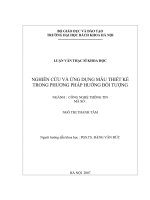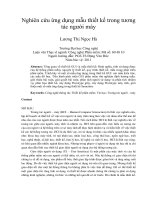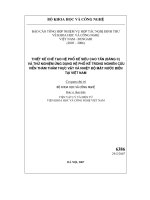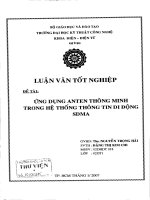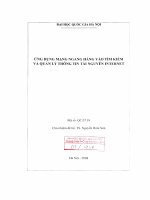part 5 simulation ứng dụng địa thống kê trong tìm kiếm thăm dò dầu khí
Bạn đang xem bản rút gọn của tài liệu. Xem và tải ngay bản đầy đủ của tài liệu tại đây (1.94 MB, 64 trang )
St h ti Si
Stochastic
Simulation
l ti
…. all I want is ONE answer
St h ti Si
Stochastic
Simulation
l ti
Estimation Vs. Simulation
Sequential Gaussian Simulation
Indicator Simulation
Boolean Simulation
Flow Chart of Steps in Stochastic
Modeling
Modeling structural
and erosional maps
Well observations, outcrops,
sedimentological knowledge,
seismic,
i i variograms
i
...
Modeling of facies
Modeling
petrophysics
Simulation grid
geometry
(modified from Tyler and others, 1994)
Upscaling
Reservoir
production
simulation
Petrophysical
p y
Property
p y Modeling:
g
Prerequisites
Workk within
W
ithi “homogeneous”
“h
” lith
lithofacies/rock-type
f i / kt
classification
l
ifi ti
Sequence stratigraphic framework
Clean data: positioned correctly, manageable outliers, grid spacing is appropriate
Need to understand special features and “special”
special data:
trends
production data
seismic data
Considerations for areal grid size:
practical limit to the number of cells
need to have sufficient resolution so that the upscaling is meaningful
this resolution is required even when the wells are widely spaced (simulation
algorithms fill in the heterogeneity)
Work with “grid nodes”. We assign a property for the entire cell knowing that there
are “sub-cell” features
St h ti Si
Stochastic
Simulation,
l ti
Why?
Wh ?
From a limited number of samples we are asked to build a complete numerical
model
d l off attributes
tt ib t such
h as permeability
bilit and
d porosity
it
There are many ways to build a model which is consistent with the available
sampled data
Whatever p
procedure we choose to build our model,, we must consider the
following:
the distribution of values
the variability of value
the
th connectedness
t d
off extreme
t
values
l
our ability to assess the impact on our uncertainty
E ti ti versus Si
Estimation
Simulation
l ti
Estimation is locally accurate and smooth, appropriate for visualizing trends,
inappropriate
pp p
for flow simulation where extreme values are important,
p
, and does
not assess global uncertainty
Simulation reproduces histogram, honors spatial variability (variogram),
appropriate for flow simulation, allows an assessment of uncertainty with
alternative realizations possible
Si l ti V
Simulation
Vs. K
Kriging
i i
Simulation
Output
Properties
Image
Use
Kriging
• Multiple Equiprobable
Realizations
• One Deterministic
Model
• Honors Wells
• Honors Histogram
• Honors Variogram
g
• Noisy
• Same variability
everywhere
• Flow Simulation
• Uncertainty Calculation
• Honors Wells
• Honors Variogram
• Smooth away from
wells
• Mapping
pp g
• Volumetrics
St h ti Si
Stochastic
Simulations
l ti
Simulation differs from estimation (kriging in two ways)
Kriging provides a Best Local Estimate without regard to resulting spatial
variability. In simulation, global features and statistics take precedence over local
accuracy
Kriging provides a single numerical model (BEST). Simulation provides many
alternative models (Each is a good representation of the reality in some global
sense)
St h ti Si
Stochastic
Simulation
l ti
We want to utilize the measure of uncertainty that is returned in the kriging process
We want the simulation to honor our variogram and our data at the well locations
We want to build numerous, equiprobable reservoir models to capture our uncertainty
i th
in
the d
data
t
We would like to flow-simulate these alternate reservoir models to obtain a
distribution of flow response variables
Si l ti R
Simulating
Reservoir
i H
Heterogeneity
t
it
Major heterogeneity's and large scale structure should be modeled first. The large
scale structures has a major influence on volumetrics and fluid movement
If the reservoir consists of a mixture of different statistical populations, the geometry
of the populations should be simulated first and then filled with continuous fields of
properties
Reproduction of the spatial continuity of extreme values should be given priority (flow
barriers and channels)
U
Uncertainty
t i t
Multiple images of the reservoir, each honoring all the data, quantify the remaining
uncertainty of the reservoir model
Flow responses in multiple images of the reservoir quantify the uncertainty in
production forecasts
St h ti Si
Stochastic
Simulations
l ti
Should the user retain one or more realization?
One realization
model statistics most likely not to be match
many realizations
which one do you retain?
How many realizations should be generated?
The answer depends on:
Aspect
p
of uncertainty
y or the statistic being
gq
quantified
Precision with the uncertainty assessment is required
Presence of correlation between the realization
Few realizations are required to assess an average statistic such as the average
porosity.
it 20 realizations
li ti
iis quite
it reliable.
li bl 500 realizations
li ti
will
ill nott significantly
i ifi
tl iimprove
our estimate. A large number of realizations are required too assess an extreme
percentile of a distribution. At least 200 realizations would be required to determine
the 1% percentile of the pore volume distribution
More realizations lead to less uncertainty
Comparing Alternative Stochastic
Models
Generate plausible realizations in a reasonable amount of time
Honor as much pertinent information as possible
Explore the largest space of uncertainty
Conditional Simulation of Flow
Processes
Flow simulations in conditional simulations of reservoir flow properties can be used to
assess the impact of reservoir heterogeneity on oil recovery
The level of resolution of flow property variations in conditional simulations is higher
than can be accommodated in full field simulation
Alternative: Stream Line Simulation
An important use of conditional simulations is for determining the scaling law for
displacements in heterogeneous media and deriving effective flow properties for use
in coarse grid simulations
Si l ti M
Simulation
Methods
th d
Gaussian Methods
Sequential Gaussian Simulation
Truncated Gaussian Simulation
Indicator Methods
Sequential Indicator Simulation
Boolean Methods
Simulated Annealing
Conditional Simulation Example
using Well and Seismic Data
Well Data
Ri k M
Risk
Map
Variogram
Model
Conditional
Simulation
Kriging or
Cokriging
R li ti
Realizations
Seismic Data
Net Sand
Probability
Why Sequential Gaussian
Simulation?
1.
2.
3.
4.
Gaussian simulation is used because it is extraordinarily straightforward to
establish conditional distributions: shape of all conditional distributions is
Gaussian (normal) and the mean and variance are given by kriging
Transform data to “normal space”
Establish grid network and coordinate system (Zrel-space)
Decide whether to assign data to the nearest grid node or keep separate
Determine a random path through all of the grid nodes
(a) search for nearby data and previously simulated grid nodes
(b) construct the conditional distribution by kriging
(c) draw simulated value from conditional distribution
5. Back transform and check results
⇒ Price of mathematical simplicity is the characteristic of maximum spatial entropy,
i.e., low and high values are disconnected. Not appropriate for permeability.
S
Sequential
ti l G
Gaussian
i Si
Simulation
l ti
Advantages
Relatively Fast
Well understood
Good implementations
Disadvantages
Does not handle litholgic or indicator variable very well
single variogram model
impossible to specify different spatial correlation characteristics for extreme
values
requires a normal model
extreme values are very poorly correlate.
Step 1 - Do Normal Scores
Transformation
Standard Normal Cumulative Distribution
1
0.9
0.8
0.7
0.6
05
0.5
0.4
0.3
0.2
01
0.1
0
Cumulative Probability
Cumulative Probability
k Cumulative Distribution
0
20
40
60
Permeability, md
80
1
0.9
0.8
0.7
0.6
05
0.5
0.4
0.3
0.2
0.1
0
-3
-2
-1
0
z
1
2
3
Step 2 - Assign data values to
closest grid nodes
Step 3 - Establish random path
1
10
5
4
17
14
28
26
32
15
7
23
19
9
3
27
11
8
21
31
22
18
24
16
6
34
2
35
20
25
12
29
33
13
36
30
St 4 - Visit
Step
Vi it every cellll once
Informed cells shown in yellow
Do kriging, generate conditional distribution
Populate current cell, Move on
1
4
5
10
14
17
7
15
32
23
26
28
3
8
9
11
19
27
16
18
21
22
24
31
2
6
20
25
34
35
12
13
29
33
36
30
St 4 - Visit
Step
Vi it every cellll once
Do kriging, generate conditional distribution
Populate current cell, Move on
11.9
20.4
10.0
29.1
14.7
21.8
21.9
7.8
29.6
17.1
12.7
27.1
14.1
25.4
10.6
16.2
10.5
7.3
S
Sequential
ti l IIndicator
di t Si
Simulation
l ti
An indicator is simply a data transform
An indicator variable is a binary variable that has only two possible values - 0 or 1
Indicators allow different ranges of the data to be modeled with different variogram
f
functions
ti
I di t Variables
Indicator
V i bl
The 0’s and 1’s could be used to designate two categorical variables
0 represents Shale
1 represents Sandstone;
the 0’s and 1’s could be used to separate continuous value into categories
0 represents k < 10md
1 represents k> 10 md
Wh Indicators?
Why
I di t ?
Advantages
easy to understand and use
robust data representation with regard to extreme values
allows us to analyze and model different measures of spatial continuity
(variograms) for different thresholds (cutoffs) or categories (facies) of the data
provides a complete distribution of indicator valued (cdf). Instead of a single
mean value at each estimation point
p
allows for the integration of hard and soft data when applying estimation of
simulation techniques
